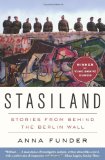 When I was a child in the 70s, I used to sometimes lie awake at night and worry about the Communists. All the stories I’d heard terrified me, and I had nightmares about my parents being shot by them; why exactly was unclear. When the Berlin Wall fell, I was amazed. It seemed to have happened so quickly. I read in the papers about the incredible reach of the Stasi, the Secret Police, and how pretty much everyone informed on everyone else, no detail too small or insignificant for their ever-reaching glare. My fascination was rekindled after watching the excellent movie The Lives of Others
When I was a child in the 70s, I used to sometimes lie awake at night and worry about the Communists. All the stories I’d heard terrified me, and I had nightmares about my parents being shot by them; why exactly was unclear. When the Berlin Wall fell, I was amazed. It seemed to have happened so quickly. I read in the papers about the incredible reach of the Stasi, the Secret Police, and how pretty much everyone informed on everyone else, no detail too small or insignificant for their ever-reaching glare. My fascination was rekindled after watching the excellent movie The Lives of Others. If you haven’t seen it, I highly recommend it—it’s one of my favorite movies.
Australian writer Anna Funder was also fascinated. She lived in West Berlin during the 1980s and obsessed a little about what was behind that wall. In 1994, 5 years after the wall fell, she lived for a while in Leipzig, and later returned to live again in Berlin. She interviewed many East Germans and has written their stories in Stasiland: Stories from Behind the Berlin Wall. The subject matter is endlessly fascinating, and Funder interviews both regular citizens and former Stasi officers. What takes the book up a notch, however, is her writing ability. The book is as easy to read as a novel, as beautifully-crafted as literature. It feels very personal, as the author shares her own thoughts and reactions to people and places.
She interviews Miriam, who nearly escaped to West Berlin as a 16-year-old and was caught and punished brutally, who later was let out of prison and happily married for only a short while, until her husband was taken in for questioning and died in a Stasi remand cell. Her life since liberation has been spent trying to find out what happened to him. The rumours are that the Stasi buried an empty coffin, that her husband hanged himself, that he escaped and is still somewhere. Miriam only wants the truth. She tells Funder of the “puzzle women” in Nuremberg. When the Stasi finally fell, they quickly shredded incriminating documents, but left the shards in huge garbage bags. Volunteers are now painstakingly piecing together these documents. Maybe, Miriam dreams, they will put together something about her husband Charlie, and she can finally be at peace.
Funder, a couple of years later, visits the “puzzle women” and finds both men and women working in pleasant offices, windows wide open. It takes hours to piece together a single sheet of paper, and there are millions. It’s a hopeless, Sisyphean task.
Funder hears tales of live behind the wall; of state-owned television, of underground rock stars (she drinks with the former frontman of a rock band who was once told to his face that he “no longer existed” by a Stasi officer). She sees first-hand the unrepentance and callousness of the former Stasi officers, some of whom act as if the state never died. She meets a woman separated from her sick baby by the overnight building of the wall, and meets that baby, now an adult, raised by doctors and nurses in a hospital ward because his parents were trapped in East Berlin. And over and over she asks the question: is it better to know what happened and bring it all out in the open, or is it better to bury the dead past and begin anew? She doesn’t answer the question per se, but instead leaves it hanging, allowing it to percolate in the reader’s mind as we meet people who have answered it in different ways in their own lives.
Stasiland is an excellent book. It won the Samuel Johnson prize for nonfiction (prestigious prize in UK. I had never heard of it either) and has been translated into many languages. I am also giving it my first ever 5-star rating. It’s that good. I highly recommend it.
Don’t miss a thing: Check out our current giveaways. Subscribe to our feed or video reviews on YouTube. Follow us @5M4B on Twitter or on Facebook.
Elizabeth is an avid reader who loves well-written books on a variety of subjects. Learn more at her blog Planet Nomad.